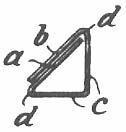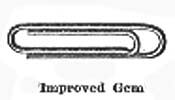 Duthie, A.
B. (2003). A Letter on:
The Fork and the Paperclip: A Memetic Perspective.
Duthie, A.
B. (2003). A Letter on:
The Fork and the Paperclip: A Memetic Perspective.
Journal of Memetics - Evolutionary Models of Information Transmission,
8.
http://cfpm.org/jom-emit/2004/vol8/duthie_ab.html
 Duthie, A.
B. (2003). A Letter on:
The Fork and the Paperclip: A Memetic Perspective.
Duthie, A.
B. (2003). A Letter on:
The Fork and the Paperclip: A Memetic Perspective.
Journal of Memetics - Evolutionary Models of Information Transmission,
8.
http://cfpm.org/jom-emit/2004/vol8/duthie_ab.html
A. Bradley
Duthie
Southern Illinois University Edwardsville
aduthie@siue.edu
Recently, there has been much debate on what should and what should not be considered part of the science of memetics. Aunger (2002) notes the familiar fault line between "those who advocate the contagion-like or viral metaphor and those who prefer the gene metaphor" with both groups appearing to claim that the other is retarding progress in memetics. Perhaps, however, it is not so much the metaphor that is retarding the progress in memetics, but the debate itself. If memetics were to focus on real-world examples of supposed memetic phenomena, then we might move beyond metaphor debates, and begin providing people with insight and understanding about the world around us.
Take, for example, the evolution of a simple artifact such as the dining fork. A brief investigation into the origin of forks reveals the surprising fact that forks are in fact descended from knives (Petroski 1992). During the Middle Ages, people began to eat with two knives, using one knife to cut food and the other to spear and bring food to the mouth. The fork first appeared as a variation on this practice, with the second knife being replaced with a two-tined prong that was more effective in picking up food. Although it is unclear precisely when these 'knife-replacements' started appearing, we know for certain that dining forks were used in the eleventh century in Tuscany among the wealthy, against the express wishes of the church (Panati 1989). There is also evidence that dining forks were used in royal courts in the Middle East as early as the seventh century.
The purpose here is not to provide a
memetic history of the dining fork, but to suggest that such a history
would be interesting. By taking a memetic approach, we ask two simple
questions: where do forks come from, and why have certain fork variants
been selected over others? Answers to these trademark questions of
origins and selection might provide unique insights into these everyday
artifacts. For example, such a memetic account could explain the
origins
of the standard four-tined fork that we use today, whilst providing a
rationale for how it came to be selected over three-, five- and
six-tined variants.
A second example of memetics in action is the paperclip, which has also evolved through a pattern of descent with modification and differential selection. Patented in 1867 by Samuel B. Fay, the paperclip (Figure 1) was originally designed to compete with the pin in holding materials together: Thus, the pin is to the paperclip what the knife is to the fork. Originally, the clip was advertised to be used to fasten fabric, not paper, but by the late nineteenth century its principal use had evolved to fasten papers together (Early Office Museum 2002).
After Fay's first patent, a number of
variant paperclips appeared that were designed for specific purposes,
such as the Wright paperclip (Figure 2) designed
specifically as a newspaper clip and patented in 1877. Other variants
afforded superior performance in certain circumstances, such as being
particularly good at holding papers securely or in being the optimal
choice for large stacks of papers.
 |
 |
 |
 |
 |
 |
 |
| Figure 2 |
Figure 3 |
Figure 4 |
Figure 5 |
Figure 6 |
Figure 7 |
Figure 8 |
The figures above shows a number of
different designs of paperclips.
All of these pictures were obtained from http://www.officemuseum.com/paper_clips.htm
The paperclip variant with which we are
most familiar today is the GEM paperclip (Figure 6), named after the British company that made
them. There is no patent record for this variant, but a machine for
manufacturing them was patented in 1899 (Lienhard
2003). Unlike other paperclips appearing around this time, such as
the 1897 Cole paperclip (Figure 3) and the 1897
Reeve paperclip (Figure 4), the GEM
paperclip was similar to the 1900/1901 Norwegian Vaaler paperclip (Figure 5) insofar as it did not have projections of
wire sticking out from it. With its "loop within a loop" design (Kendall 1999), credit for the GEM paperclip's
popularity has been attributed to its aesthetic appeal (American Association of Engineering Societies 2003).
Variations of the successful GEM paperclip have
been subsequently proposed (Figures 7 & 8), with the Perfected GEM (Figure
8) appearing in 1934 as an easier to use version, providing a
better grip, as well as being less likely to scratch paper because of
new square ends that lined up with the edge of the paper.
Again, the purpose here is not to provide a detailed memetic account of paperclip, but to suggest that such an account could be interesting and insightful. By asking the twin memetic questions of where do today's paperclips come from (their evolutionary lineage), and why certain variations have been selected instead of others (differential selection), we can demonstrate the relevance and utility of memetics in understanding and explaining the world of artifacts around us.
American
Association of Engineering Societies (2003) Paper Clip: Design.
21 Apr. http://www.voicesofinnovation.org/archives/Apr_03/P166_4_21_03.asp
Aunger,
R. (2002) The Electric Meme: A New Theory of How We Think. New
York, NY: The Free Press.
Early
Office Museum (2002) History of the Paper Clip. http://www.officemuseum.com/paper_clips.htm
Kendall, N.M. (1999) Getting a Grip - On
Paper. Christian Science Monitor. http://www.csmonitor.com/durable/1999/03/09/fp22s1-csm.shtml
Lienhard,
J.H. (2003) Engines of Our Ingenuity: No. 769: The Paper Clip.
University of Houston. http://www.uh.edu/engines/epi769.htm
Panati,
C. (1989) Extraordinary Origins of Everyday Things. New York:
Harper & Row.
Petroski,
H. (1992) The Evolution of Useful Things. New York: Vintage
Books.